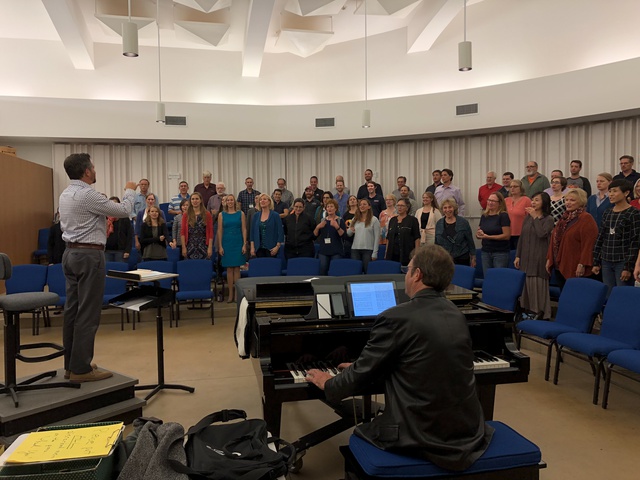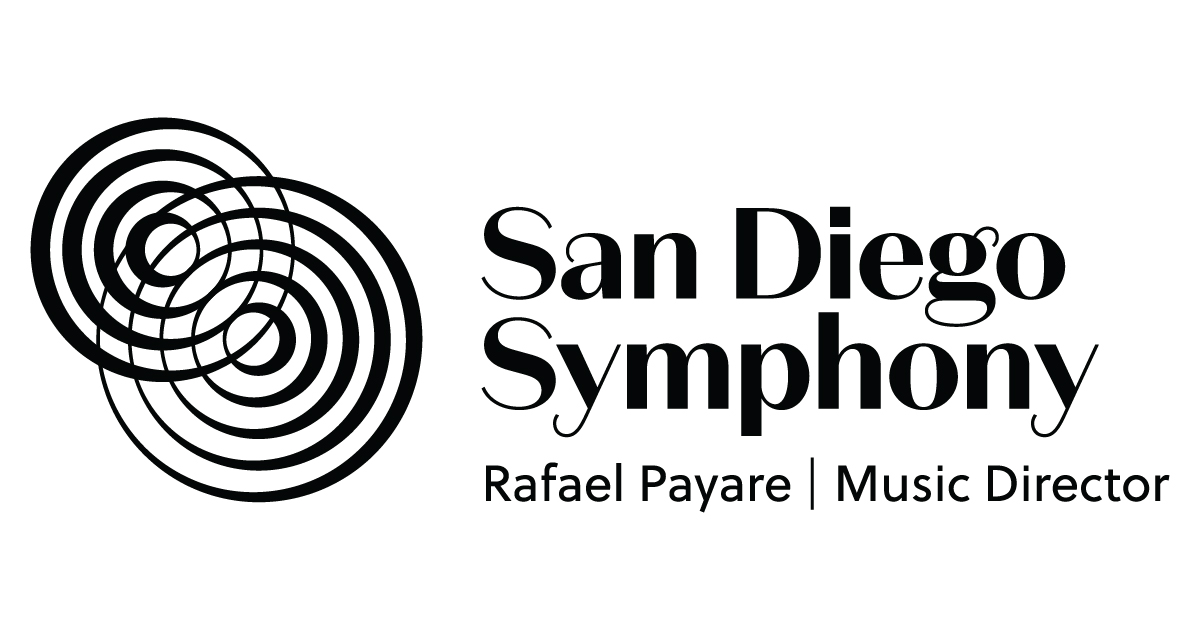The Road to the Requiem: How the San Diego Master Chorale is preparing to take on Mozart

This past Monday evening, the San Diego Symphony marketing department took a field trip to Mission Valley to watch the San Diego Master Chorale rehearse Mozart’s Requiem. Mozart’s famous final work, which is being performed this November as part of our season, is just as much a choral piece as it is an orchestral piece. With a little help from our friends from the Master Chorale and four international soloists, we’ll be bringing this behemoth of a concert to our stage for what is sure to be an unforgettable weekend.
We’re very familiar with orchestra rehearsals, so we figured it was time to expand our horizons and see what the choral side of the rehearsal process was all about. John Russell, the Master Chorale’s music director, graciously allowed us to sit in as he worked with his chorus on the first part of the Requiem. Before the rehearsal started, John talked to us about the unique challenges the chorus faces while preparing for such an important and demanding piece. He explained that because the chorus sings throughout the entire Requiem (as opposed to just parts of the piece) it is truly a test of endurance for the singers. This makes the need for frequent and meticulous rehearsals very crucial. Since the piece is so iconic and familiar to many audiences, the singers and musicians are faced with the challenge of making their rendition memorable. Russell is intent on making their performance not-just-another-Requiem, so his challenge lies in finding the subtleties in the music that he can make interesting and exciting.
As an objective observer, I can say with complete confidence that Russell will achieve that “interesting and exciting” goal. I’ve never sat in on a professional choir rehearsal before, but I can now tell you that being in such close proximity to at least 50 of the most stunning voices I’ve ever heard all singing in perfect harmony was a gift to my ears. From the second they began to sing, the power of their voices together filled the rehearsal room and immediately grabbed my attention. While watching the entire chorus sing together was a spectacle in itself, it was also fascinating watching the different sections take on their own parts of the song. From the striking clarity of the sopranos and tenors to the smoothness of the altos and basses, the shifts in section from minute to minute kept me alert and interested in what would come next. Throughout the rehearsal, Russell would pause the chorus to give them notes and polish different parts of the song. Russell also explained to us that our guest conductor for the concert, Markus Stenz, had sent him notes about details of the piece that he wanted them to focus on. Every conductor puts their own spin on the piece, Russell explained, so it’s important he communicate their preferences to the chorus while he rehearses with them. His moments of coaching were a testament to what a true ear he has for choral music, as everything sounded absolutely perfect to me.
Imagine, if you will, the experience I just described but inside the beautiful Copley Symphony Hall, accompanied by a full orchestra and four professional soloists. If that sounds like something you’d be into (and I’ll bet it is), visit www.sandiegosymphony.org to see how you can get tickets to see it in person.
BONUS: Keep reading for the entirety of our fascinating interview with John Russell, music director of the San Diego Master Chorale!
Q: Can you describe the significance of Mozart’s Requiem, not just as an orchestral piece, but as a choral piece?
A: The choir sings throughout the entire work. It’s challenging because it’s an endurance test for the singers in a way. They sing right from the opening of the piece and all the way through to the end and intersperse with the four soloists. The amount of vocal writing for the piece is the first challenge. The second challenge is, for a group like the Master Chorale and for players like the Symphony, the familiarity of the music. The technical aspects are always difficult but the familiarity of the piece and revisiting it without putting a stamp of a different performance on it – making every performance and every rehearsal lively and interesting until the end - Mozart wanted it dramatic – is a challenge for many of the singers who have done it many times. To revisit this work is really a joy for many of us, but the challenges come with the imitative writing that Mozart puts in the first sections of the Requiem. They are exciting and challenging for the length of line and the speed and agility that the lines require of many of the singers. For some of the demands, it’s important to have rhythmic and articulate precision throughout the entire opening part of the requiem.
Q: How is the Requiem significant in the larger world of classical music?
A: There’s a lot of mystery that surrounds the composition of the Requiem and the film Amadeus dramatizes that and the play dramatizes that. It takes it maybe past truthfulness to some degree, but the essence of the mystery is really there. It’s an incomplete work by Mozart and probably his most popular work at the same time, so that dynamic always creates interest for the audience and for singers, performers and conductors. That’s why we keep coming back to it – it’s the mystery of the work. The Requiem as a text and as a chant goes back thousands of years. The actual composition of the Requiem for an orchestra and a chorus is something that evolved in the Classical period into the Romantic period, and we’re starting to see concertizing of this music in a way that was new. It elevated the Requiem to the level of opera with the format that Mozart chose: the quartet of soloists along with the chorus, the demands of vocal writing and the drama that’s written into the text itself. It has become sort of an offshoot for other composers to do even more with the text. The text itself is inherently dramatic – the Day of Wrath and the Day of Judgment. All of those things are exciting to sing and listen to. If you trace those exact texts back in history and then forward in history from the time of Mozart, it’s interesting to see how other composers treated the same material. In fact, the Fauré Requiem doesn’t even include the Day of Wrath text setting at all – it is a completely different type of Requiem. This fits in a long history of Requiem texts, chants and masses set by composers for thousands of years.
Q: What kind of preparation must the chorus undergo in order to perform this piece alongside the orchestra?
A: The chorus rehearses weekly for this Requiem. We rehearse at the First United Methodist Church every Monday evening. We set up a rehearsal schedule that starts from several piano rehearsals – the choir and our pianist rehearse together for several weeks by ourselves. We communicate with the orchestra and with whoever the conductor is going to be for the performance. In this case, Markus Stenz sent us materials that he wanted us to rehearse and details to incorporate into our preparation. Music by Mozart and of this period requires a little bit of interpretation in terms of articulation, and there are some decisions that some conductors might make and other conductors might not make. With that information, we prepare our rehearsals and work our way through the score, trying to hit all of the movements multiple times. We take them apart, work them and reduce texture then put the piece together with everybody, slowly preparing to hand the chorus off to the Maestro. The Maestro will be here in a couple of weeks to work with the chorus then rehearse with the orchestra and eventually put everything together piece by piece. Our rehearsal schedule and rehearsal demands for the Mozart are substantial and putting that together takes time and the chorus has to be selective. In this case, we’re a smaller size than usual. That’s another aspect of decision making in Symphony preparation. This is all for what we hope will be a really dramatic and exciting performance.
This post was written by Stephanie Zumwalt, Marketing and Public Relations Coordinator for the San Diego Symphony.
Share ArticleBack to all posts
